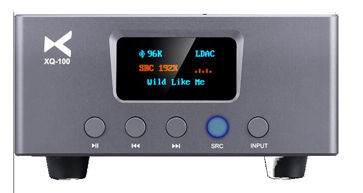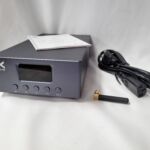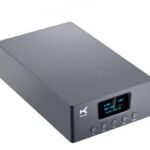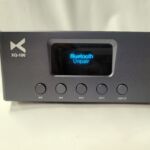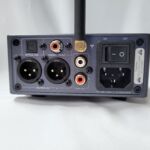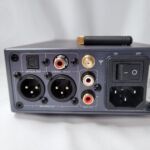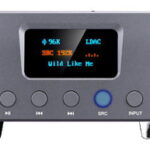Xduoo XQ-100
Wireless is taking over the earphone market and making in-roads in the headphone market but on the desktop side Bluetooth devices have lagged a bit. Sure streamers are popular as add-ons to older 2-channel setups but high-end systems usually don’t sport wireless sources. There has been a good reason for that as early Bluetooth protocols were both unreliable and limited bit-rates to what amounted to a mid-range MP3 file. You wouldn’t buy a Ferrari and then fill the tank with low-octane cheap gas, and audiophiles don’t buy highly resolving systems only to feed it poor quality input.
With the advent of the newest generation of Bluetooth Codecs those limits are being raised and we are starting to see the potential for wireless to offer sound as good as wired options. Protocols like AptX HD and LDAC are now capable of near CD-quality audio. For those that argue Bluetooth 4.2 and 5.0 don’t have the bandwidth to support true lossless, I would counter that fully 99% of 16/44 lossless music can be compressed to between 300kbps and 900kbps. Note I said music not sound. White noise will not compress because there is no pattern or correlation and thus Bluetooth lacks the bandwidth to transmit it losslessly. So if listening to music, Bluetooth is realistically capable of 16/44 lossless, if you spend your days listening to non-patterned noise, well maybe not so much. I don’t normally link other sites but for those interested in more detail I recommend Robert Trigg’s article on LDAC.
That is the first hurdle to putting a wireless streamer in a higher end system, but it isn’t the only one. Most of the Bluetooth streamers to date have been designed as add-ons to older systems and typically incorporate a DAC and amplifier into the streamer and have analog RCA outputs so they can be plugged into an unused CD, tape, or Phono input. While this is a good thing for those looking to quickly add wireless to their 1980s Kenwood, it isn’t the design desired by those with high end systems. Those with systems that already incorporate a DAC want a streamer that feeds a digital output to the DAC in their system rather than processing the sound and feeding it to an analog input.
There have been some attempts to bypass the DAC and amplifier in some streamers and some DIY attempts to build streamers that output I2S that can be fed directly into a DAC but most of these have remained niche players at best.
The latest XDuoo XQ-100 streamer attempts to change that. At first glance, it’s an odd combination of features and may seem counter-intuitive, but digging a bit deeper, we see the logic behind the design and the target market is the 2nd group of people mentioned above that have already built a high end system that includes a DAC and just want a way to feed it wirelessly.
The previous XQ-50 models where small boxes with USB and Bluetooth inputs and RCA outputs so could be used as a 16/48 USB DAC as well as a Bluetooth input. The XQ-100 is in some ways the big brother to the XQ-50 but in other ways a very different product. The XQ-100 is roughly 4 times the size of the 50, and sports higher build quality where it looks the part for integration into higher end systems for one. Gone is the USB input that also served as the power source for the earlier XQ’s as the XQ-100 uses a standard 110/220 power cable and has a switch on the underside for choosing between them.
The top, front, and sides of the unit are solid billet aluminum with rounded corners molded in and all anodized in steel gray. The bottom of the unit is a separate plate as is the rear and both plates are mounted with gloss black Allen head screws. The front of the unit has a large central display with control buttons beneath it for play/pause, forward, back, src, and input. The rear face is easily the busiest with (left to right) optical output, and coaxial input/output over a pair of XLR outputs, the Bluetooth antenna connection over a pair of RCA outputs, and finally the power switch over the power inlet port. Honestly, there is not space on the rear face for an additional USB input without increasing the size of the unit.
Internally, the game has changed as well. The XQ-50 was a simple circuit with a Bluetooth chip feeding a simple 9018 series DAC with an op-amp bringing the output up to 2V for feeding an RCA input on a typical stereo receiver. About the only part that has been retained in the XQ-100 is the Bluetooth receiver and even that has been upgraded to the newest CSR8675 chip. This allows the XQ-100 to support LDAC, AptX LL & HD, and AAC protocols for a wide range of compatibility with source devices. SBC is supported as a fallback if needed.
From the Bluetooth input, the signal is fed either to a CS8406 chip that handles the Optical and Coaxial outputs or to a pair of ESS9038Q2M DAC Chips. This allows users to output signal directly to an external DAC via the optical or coaxial outputs at up to 24/192 which is possible because of the built-in up-sampling capability. For those without an external DAC, the signal is instead fed through a fully balanced DAC and amplifier section to a pair of XLR outputs at an industry standard 4V and also fed to a pair of RCA auxiliary outputs at 2V for use with standard stereo inputs.
The coaxial port can also be used as an input which allows the XQ-100 to serve as a coax to optical converter or as a coaxial balanced DAC for those who prefer not to use the Bluetooth input.
The front display is easy to read and offers clear feedback about input, bit rate, protocol in use, and file name being played. (not all info is available via coaxial input).
How does it sound? Well with a THD+N of 0.0009 for optical and coaxial outputs, of 0.005% using the XLR and 0.07% for the RCA jacks, the XQ-100 is remarkably quiet and disappears into the background just as a transport should. It doesn’t do anything but accept a Bluetooth signal, and convert it to an output and pass it along and if that is what you need, it works nearly flawlessly.

